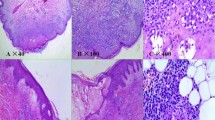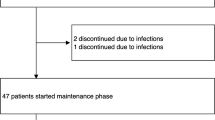Abstract
In this case report we describe a novel treatment with two chimeric monoclonal antibodies (MoAb) targeting the autoimmune B cell clone responsible for bullous pemphigoid (BP) as a manifestation of steroid refractory chronic graft-versus-host disease (GVHD) that developed after unrelated cord blood transplantation. Monitoring the BP-specific circulating antibodies and CD25-expressing activated T lymphocyte subset led us to combine anti-CD20 (Rituximab) mediated B cell ablation with anti-CD25 (Daclizumab) therapy to block CD4+ T cell help. Complete clinical and serologic response was achieved within 4 weeks of initiation of therapy allowing global immunosuppression to be dramatically reduced.
This is a preview of subscription content, access via your institution
Access options
Subscribe to this journal
Receive 12 print issues and online access
$259.00 per year
only $21.58 per issue
Buy this article
- Purchase on Springer Link
- Instant access to full article PDF
Prices may be subject to local taxes which are calculated during checkout

Similar content being viewed by others
References
Domloge-Hultsch N, Gammon WR, Briggaman RA et al. Epiligrin, the major human keratinocyte integrin ligand, is a target in both an acquired autoimmune and an inherited subepidermal blistering skin disease J Clin Invest 1992 90: 1628 1633
Grillo-Lopez AJ, White CA, Varns C et al. Overview of the clinical development of rituximab: first monoclonal antibody approved for the treatment of lymphoma Semin Oncol 1999 26 (Suppl. 14): 66 73
Ratanatharathorn V, Carson E, Reynolds C et al. Anti-CD20 chimeric monoclonal antibody treatment of refractory immune-mediated thrombocytopenia in a patient with chronic graft-versus-host disease Ann Intern Med 2000 133: 275 279
Saleh MN, Gutheil J, Moore M et al. A pilot study of the anti-CD20 monoclonal antibody rituximab in patients with refractory immune thrombocytopenia Semin Oncol 2000 27 (Suppl. 12): 99 103
Stasi R, Pagano A, Stipa E, Amadori S . Rituximab chimeric anti-CD20 monoclonal antibody treatment for adults with chronic idiopathic thrombocytopenic purpura Blood 2001 98: 952 957
Ahrens N, Kingreen D, Seltsam A, Salama A . Treatment of refractory autoimmune haemolytic anaemia with anti-CD20 (rituximab) Br J Haematol 2001 114: 244 245
Zecca M, De Stefano P, Nobili B, Locatelli F . Anti-CD20 monoclonal antibody for the treatment of severe, immune-mediated, pure red cell aplasia and hemolytic anemia Blood 2001 97: 3995 3997
Waldmann TA, O'Shea J . The use of antibodies against the IL-2 receptor in transplantation Curr Opin Immunol 1998 10: 507 512
Przepiorka D, Kernan NA, Ippoliti C et al. Daclizumab, a humanized anti-interleukin-2 receptor alpha chain antibody, for treatment of acute graft-versus-host disease Blood 2000 95: 83 89
Acknowledgements
This work was supported in part by The Lisa Stafford Memorial Research Prize, The National Marrow Donor Program-Marrow Transplant Research Grant (PSz), RO1-Al-47258-01A1 (RH), N01-HB-67141, N01-HB-67138 (JK).
Author information
Authors and Affiliations
Rights and permissions
About this article
Cite this article
Szabolcs, P., Reese, M., Yancey, K. et al. Combination treatment of bullous pemphigoid with anti-CD20 and anti-CD25 antibodies in a patient with chronic graft-versus-host disease. Bone Marrow Transplant 30, 327–329 (2002). https://doi.org/10.1038/sj.bmt.1703654
Received:
Accepted:
Published:
Issue Date:
DOI: https://doi.org/10.1038/sj.bmt.1703654
Keywords
This article is cited by
-
Bullous Diseases in Children: A Review of Clinical Features and Treatment Options
Pediatric Drugs (2019)
-
The Emerging Role of Rituximab in Autoimmune Blistering Diseases
American Journal of Clinical Dermatology (2015)
-
Rituximab in Treatment-Resistant Autoimmune Blistering Skin Disorders
Clinical Reviews in Allergy & Immunology (2008)
-
B-cell targeting in rheumatoid arthritis and other autoimmune diseases
Nature Reviews Immunology (2006)
-
Successful anti-CD20 antibody treatment of pemphigus foliaceus after unrelated cord blood transplantation
Bone Marrow Transplantation (2005)



